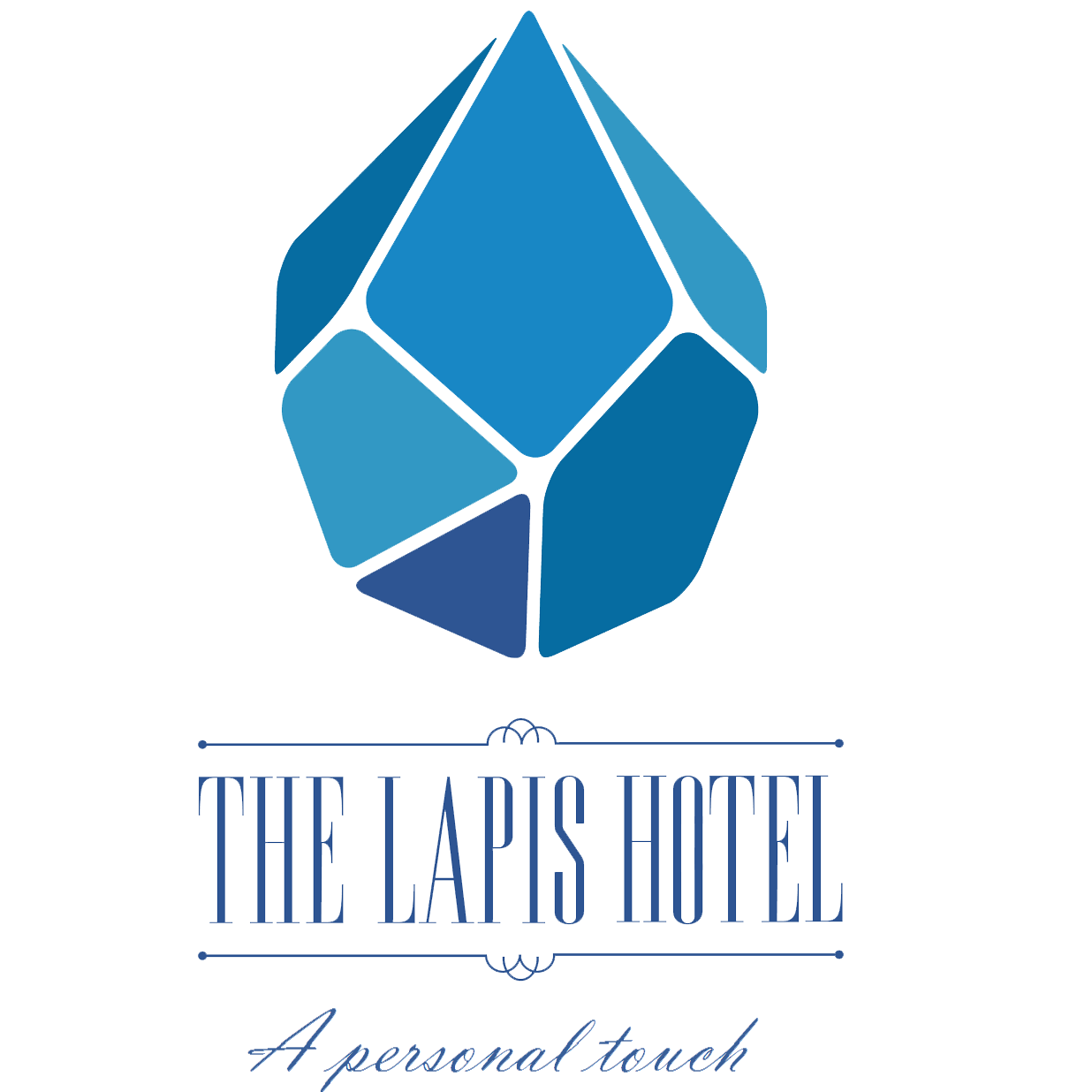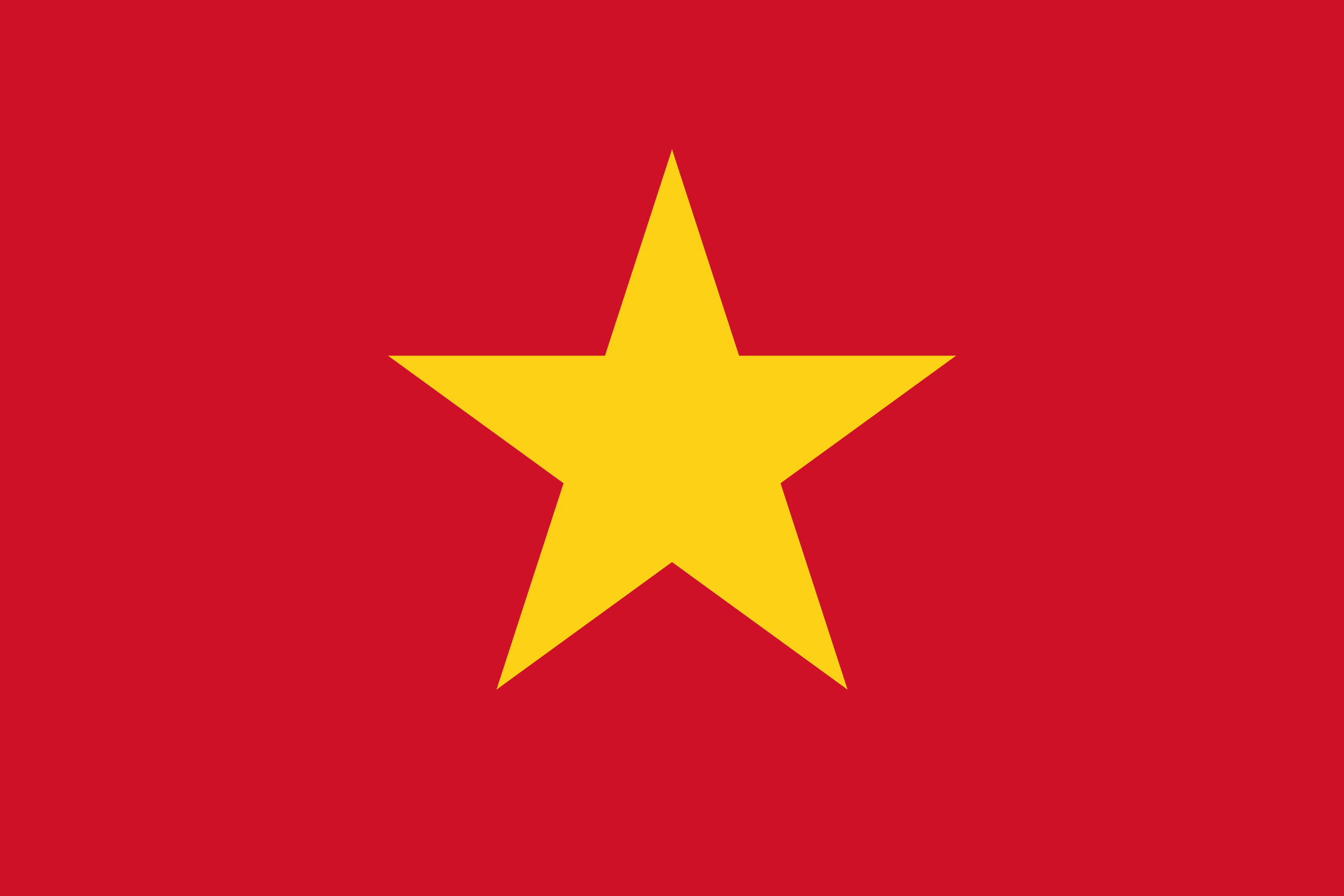Visitors can choose The Lapis Hotel as their accommodation when coming to Hanoi and wanting to visit the Temple of Literature and National University. You are free to explore this place and travel by various means
Content
- 1 The destination: The Temple of Literature and National University is just a few minutes’ walk from The Lapis Hotel.
- 1.1 Introduction to the Temple of Literature and National University
- 1.2 History of the Temple of Literature
- 1.3 What is special about the architecture of the Temple of Literature and National University in Hanoi?
- 1.4 Detailed Information and Ticket Prices for Visiting the Temple of Literature and National University
- 1.5 Touring the Temple of Literature and National University through Its Points of Interest
- 1.6 Văn Miếu Môn Triple Gate
- 1.7 Detailed Information & Specific Directions for the Tour Route from The Lapis Hotel:
The destination: The Temple of Literature and National University is just a few minutes’ walk from The Lapis Hotel.
Not only is it a famous cultural landmark, but the destination: The Temple of Literature and National University is also one of the attractive tourist destinations that attract many domestic and international tourists. Located just a short distance from The Lapis Hotel, visitors can explore this destination in many different ways. It has unique architecture, a tranquil atmosphere, and a central location in Hanoi, making it easy to travel to other accommodations and the Old Quarter.
Introduction to the Temple of Literature and National University
The Temple of Literature and National University is one of the ancient and precious cultural heritages of the Vietnamese nation. It boasts unique architectural works, bringing serenity and peace, attracting a large number of domestic and international tourists every time they visit Hanoi.
With its central location, near the Thang Long Imperial Citadel, the Temple of Literature and National University has many prominent and unique architectures such as Van Lake, Giám Garden, and the Temple of Literature – a place to worship Confucius. It includes Quốc Tử Giám, Vietnam’s first university. It is also a place of worship for three wise kings of the nation: Lý Thánh Tông, Lê Thánh Tông, and Lý Nhân Tông.
The Temple of Literature and National University is surrounded by brick walls. Inside, there are five different spaces, each with its own unique architecture, historical significance, and cultural characteristics of the Vietnamese nation.
The Temple of Literature and National University has been recognized by UNESCO as a “World Documentary Heritage” with 82 steles of doctoral laureates and is classified as a national monument.
When mentioning the Temple of Literature and National University, everyone surely knows that this is Vietnam’s first university, a place that has trained many talents for the nation. To this day, it remains a place to honor and reward students with outstanding academic and training achievements. It is also the venue for traditional and folk programs and activities, aimed at preserving and maintaining the country’s traditional cultural identity.
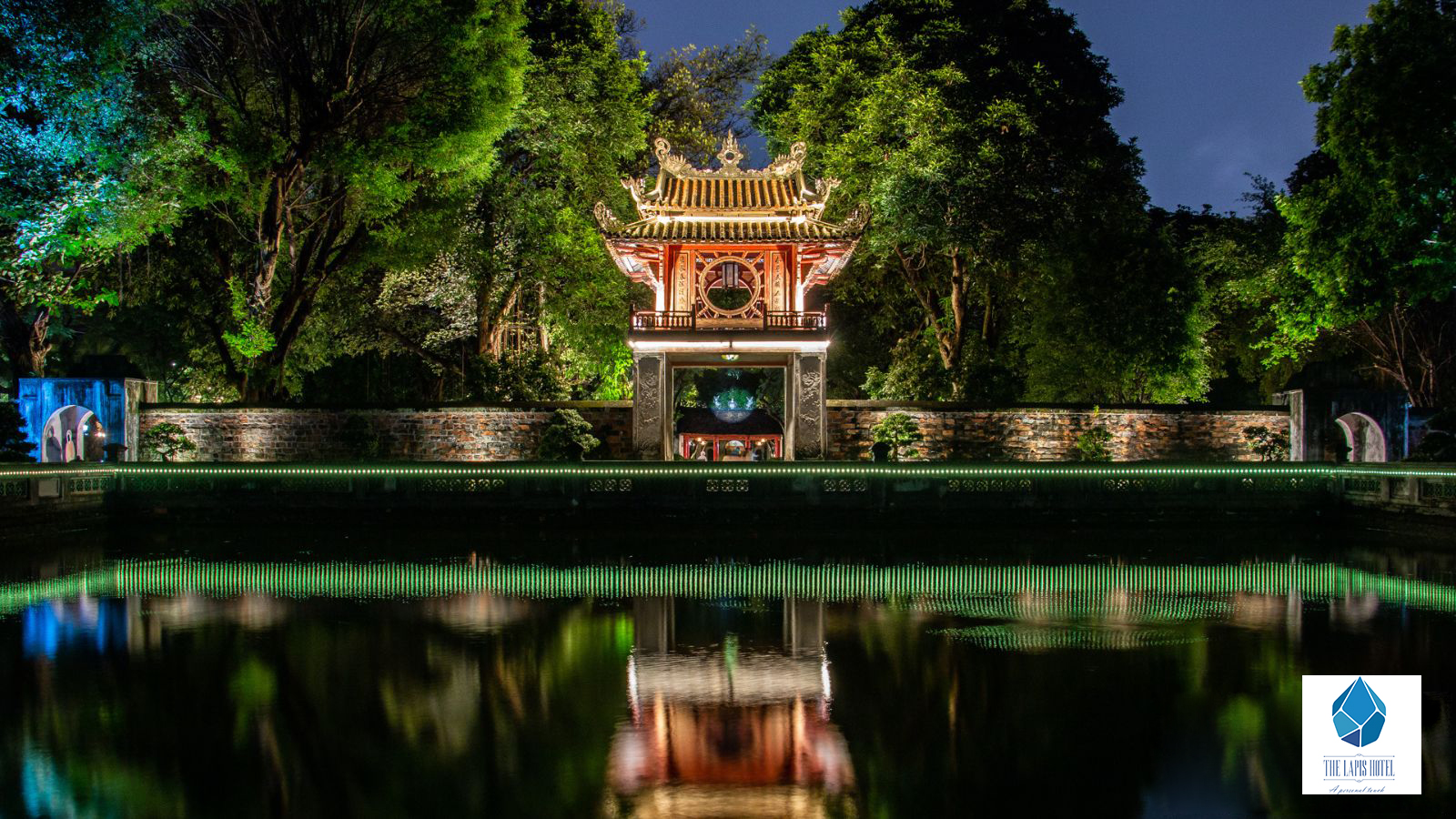
History of the Temple of Literature
If you have the opportunity to visit Hanoi or are planning a trip to the capital, visitors can start their journey with a visit to the Temple of Literature and National University. Here, you will learn about the cultural history of Vietnam.
The Temple of Literature was constructed in 1070 during the reign of Emperor Lý Thánh Tông, on a rectangular area 300 meters long and 70 meters wide, surrounded by brick walls. Quốc Tử Giám, established by King Lý Nhân Tông in 1076, was exclusively for the emperor’s sons and high-ranking officials’ families.
In 1253, Quốc Tử Giám was renamed Quốc học viện, expanded, and began accepting students who were the sons of commoners with outstanding academic achievements. During the reign of King Trần Minh Tông (1300-1357), Chu Văn An held the position of Quốc tử giám tư nghiệp, equivalent to today’s principal. He was responsible for overseeing all activities at Quốc Tử Giám and teaching the princes.
At that time, the Temple of Literature and National University was a place for training talented officials and selecting the best talents to serve the royal court.
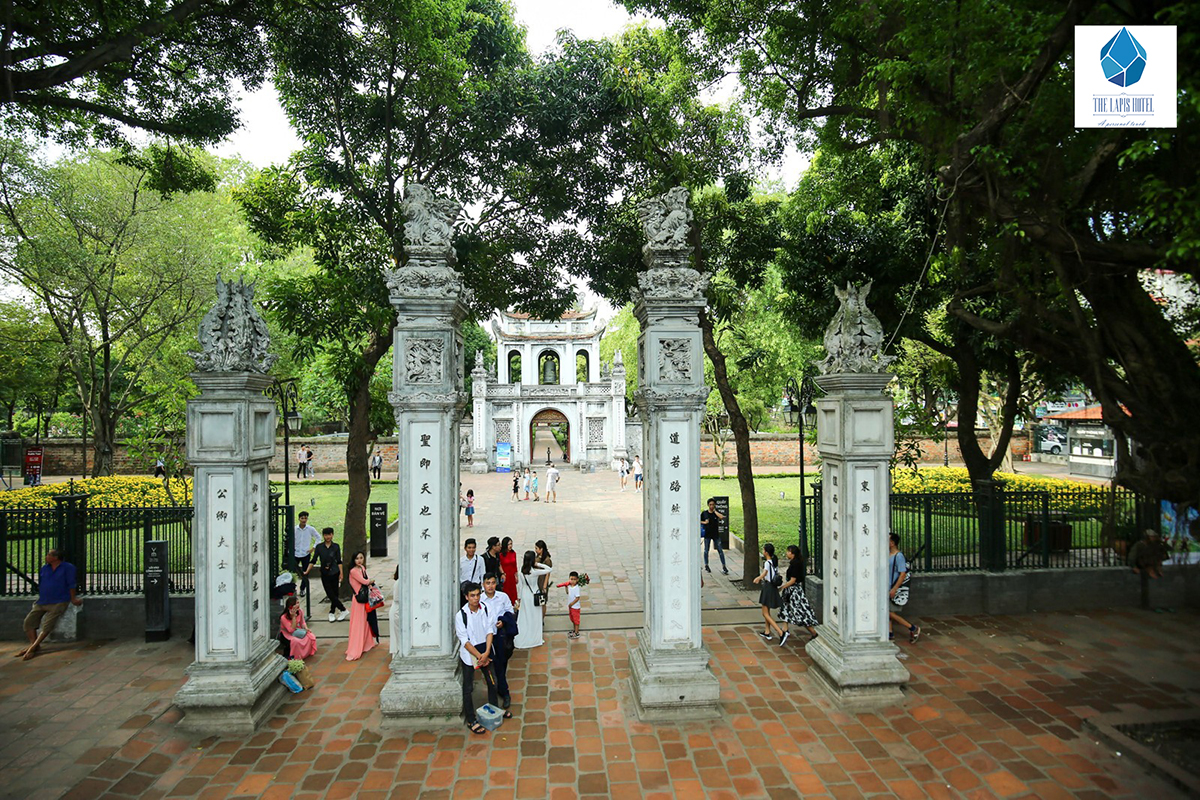
What is special about the architecture of the Temple of Literature and National University in Hanoi?
Located in a large rectangular campus with an area of 54,331 square meters, the overall site of the Temple of Literature and National University carries the architectural style of the early Nguyễn Dynasty, with unique and distinct characteristics. The campus is surrounded by solid brick walls.
Having witnessed thousands of years of history and the country’s ups and downs, the site now includes Van Lake, Văn Miếu Môn, Đại Trung Môn, Khuê Văn Các, Thiên Quang well, and the steles of the doctoral laureates, Đại Thành Môn, and the Thái Học house.
The complex of the Temple of Literature and National University is designed in a very square and logical layout along the North-South axis. In front of the Temple is a lake called Van Lake. From the entrance gate, visitors will see the four pillars, with “Hạ mã” steles on both sides, all surrounded by brick walls.
The Temple is divided into five separate areas, each separated by walls. To visit each area inside, you need to pass through a system of gates, including a main gate and two side gates.
Detailed Information and Ticket Prices for Visiting the Temple of Literature and National University
A detailed chart with information on transportation and ticket prices for visiting the Temple of Literature and National University in Hanoi. This helps tourists plan and enjoy their trip with family and friends in the best possible way.
| Content | Detail infomations |
| The distance from The Lapis Hotel to Van Mieu Quoc Tu Giam | The Lapis Hotel is located 2.3 km from Van Mieu Quoc Tu Giam. The short distance allows tourists to easily reach it quickly without spending too much time. |
| Transportation options | Walking: For the destination: Van Mieu Quoc Tu Giam, tourists can walk. This is an option for those who want to leisurely enjoy the street atmosphere and take in the surrounding scenery. |
| Bicycle/Motorbike: Tourists can rent bicycles at the hotel or nearby rental points. Bicycle rental prices range from 50,000 to 80,000 VND/day, while motorbike rental prices range from 100,000 to 150,000 VND/day. | |
| Cyclo: This traditional vehicle is widely used on the streets of Hanoi’s Old Quarter, providing customers with a unique experience while strolling around the Old Quarter. Prices range from 150,000 to 200,000 VND for a one-hour tour. | |
| Bus: Tourists can travel to Van Mieu Quoc Tu Giam by bus. This means of transport can take customers to the nearest stop to walk in. Bus fares are quite cheap, and there are many routes to choose from for suitable travel times. | |
| Motorbike taxi, Taxi: To travel quickly and conveniently, customers should choose motorbike taxi or taxi services. With a variety of technology apps from different motorbike taxi and taxi companies, customers can easily choose a quick, suitable, and fastest trip to the destination: Van Mieu Quoc Tu Giam. Tourists should consider and choose reputable services to ensure more reasonable prices. | |
| Double-decker bus: The double-decker bus is a suitable means of transport for tourists who want to visit tourist attractions in Hanoi’s streets. This type of vehicle has been newly exploited and operated in recent years. Tourists will have interesting experiences when visiting Van Mieu Quoc Tu Giam by double-decker bus. | |
| Travel Time | Walking: Travel time is about 10-15 minutes, depending on each person’s walking speed. |
| Taxi/Grab: It takes only 5-7 minutes, helping customers quickly reach the destination: Van Mieu Quoc Tu Giam conveniently without wasting time. | |
| Bicycle/Motorbike: It takes about 5-10 minutes, convenient for those who love freedom in observing and exploring Hanoi’s streets and beautiful scenery. | |
| Cyclo: The tour time usually lasts from 15-20 minutes, providing an interesting experience while traveling and sightseeing. | |
| Opening hours | Van Mieu Quoc Tu Giam is open daily to welcome visitors from all directions. Opening hours:
|
| Ticket Prices |
Dress Code: Appropriate, polite attire; no tank tops, short skirts, or shorts. Always remove hats in sacred areas. Note: This price applies to students with valid student ID cards. For disabled people and seniors, a national ID card is required. |
Touring the Temple of Literature and National University through Its Points of Interest
The complex of the Temple of Literature and National University is neatly and logically arranged, with each visiting area separated by brick walls. When you visit, you cannot miss the cultural relics within the campus of the destination: The Temple of Literature and National University:
Văn Miếu Môn Triple Gate
Văn Miếu Môn Triple Gate is the outer gate of the Temple of Literature and National University complex. The Văn Miếu Môn was built with three main gates, with the central gate being the tallest, inscribed with the three large Chinese characters “Văn Miếu Môn” in ancient Han script. The two smaller gates on either side feature unique architecture and intricately and carefully carved patterns, adding elegance to the structure. Right in front of Văn Miếu Môn, there are four pillars, along with two Hạ mã steles on either side.
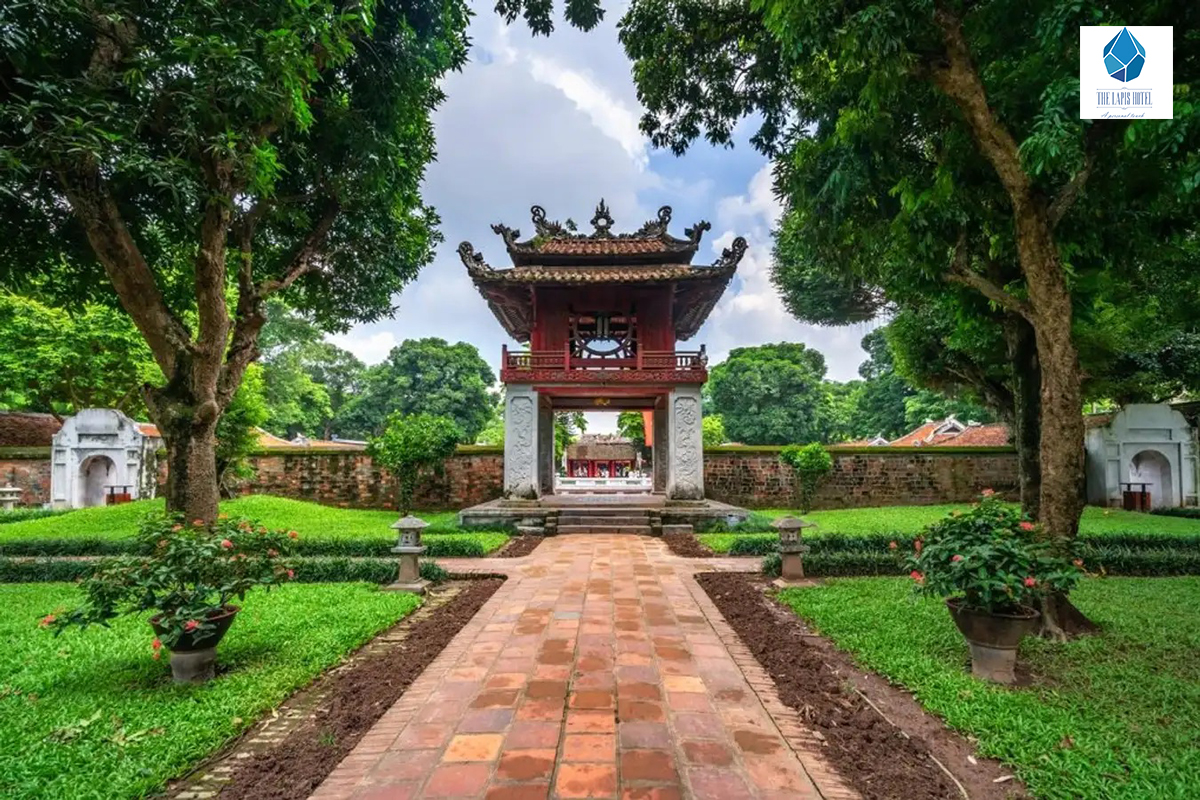
Hồ Giám
Hồ Giám, also known as Văn Lake or Đường Minh Lake, is located right in front of the Văn Miếu gate. This is a large-scale construction, with Kim Châu mound situated in the middle of Hồ Giám. On Kim Châu mound, the Phán Thủy Đường pavilion was built. Phán Thủy Đường is the place where scholars used to discuss and critique poetry and literature.
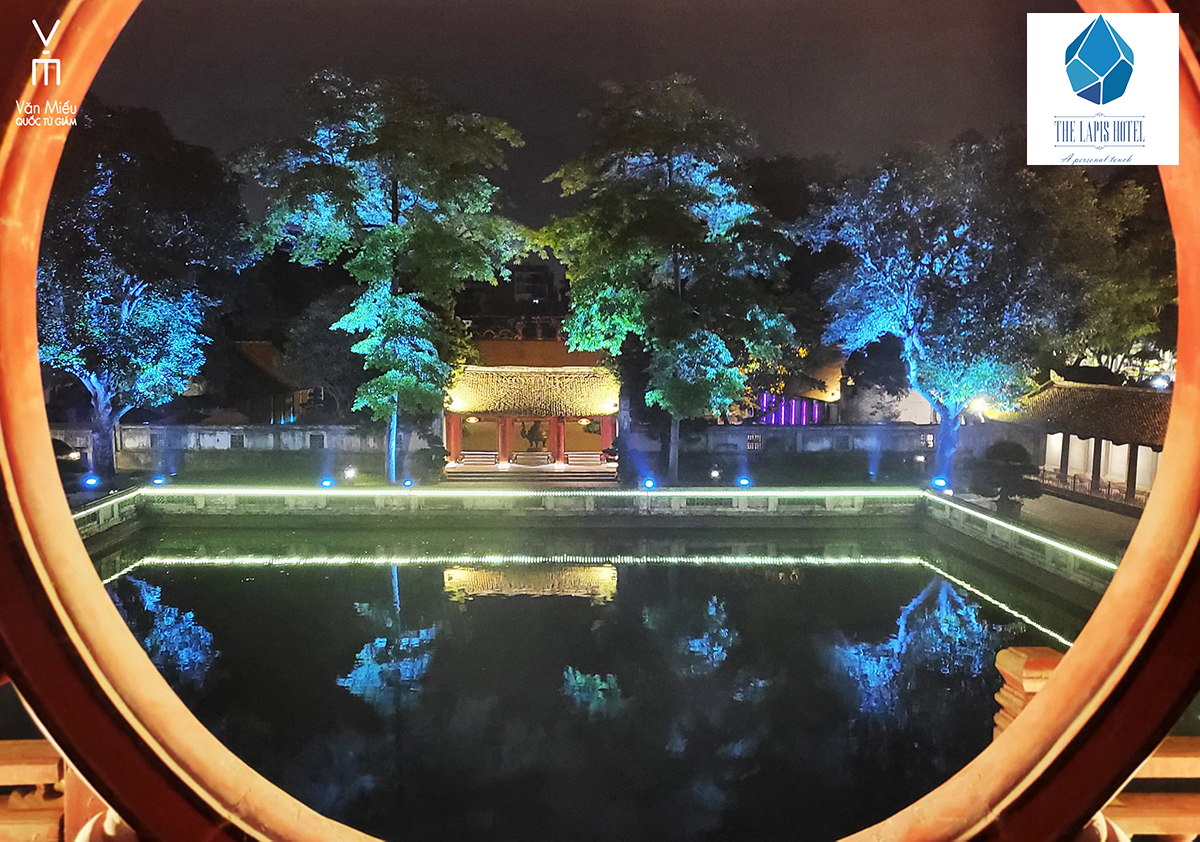
Đại Trung Môn
After passing through Văn Miếu Môn, visitors will be welcomed by a very spacious, beautiful, and solemn space at Đại Trung Môn. The gate of Đại Trung Môn features ancient architecture characteristic of a traditional Vietnamese communal house. The gate is designed with three sections, roofed with concave tiles. At the top of the gate is a carp, symbolizing students. The design implies that students need to study hard to pass exams and achieve excellent results, just as a carp must overcome great waves to have the chance to become a mighty and magnificent dragon.
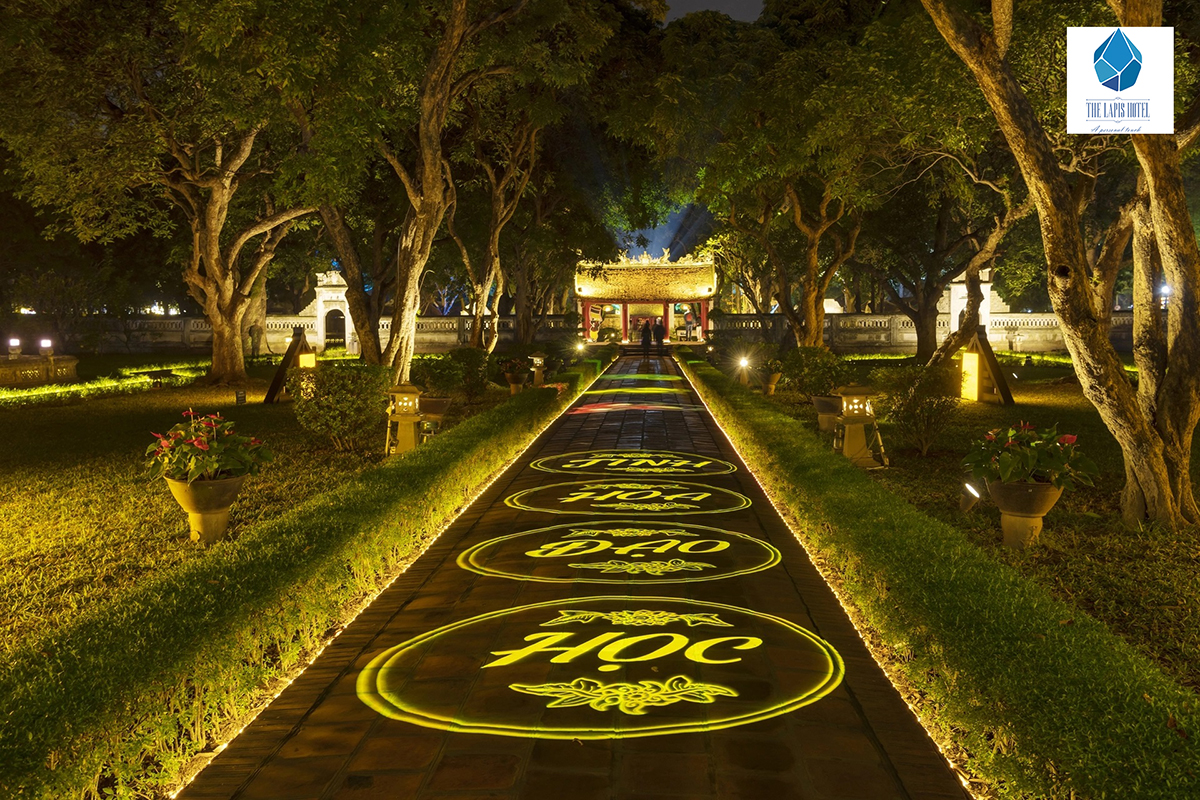
Khuê Văn Các
Khuê Văn Các was built in 1805. The structure is an eight-roofed square pavilion, consisting of four upper roofs and four lower roofs, constructed on a square foundation paved with Bát Tràng bricks and elevated about 1 meter above the ground. The lower floor consists of four square columns intricately and meticulously carved with detailed patterns. On all four sides, there are circular windows with wooden beams radiating in different directions, symbolizing the shining rays of the Khuê star.
Notably, above the pavilion, there is a gilded plaque inscribed with the three Chinese characters “Khuê Văn Các,” meaning “Khuê Văn Pavilion.” Around all four sides of the pavilion are couplets praising the beauty of Khuê Văn Pavilion and the long-lasting academic tradition. According to ancient explanations, “Khuê” is the name of a bright star in the constellation of 28 stars.
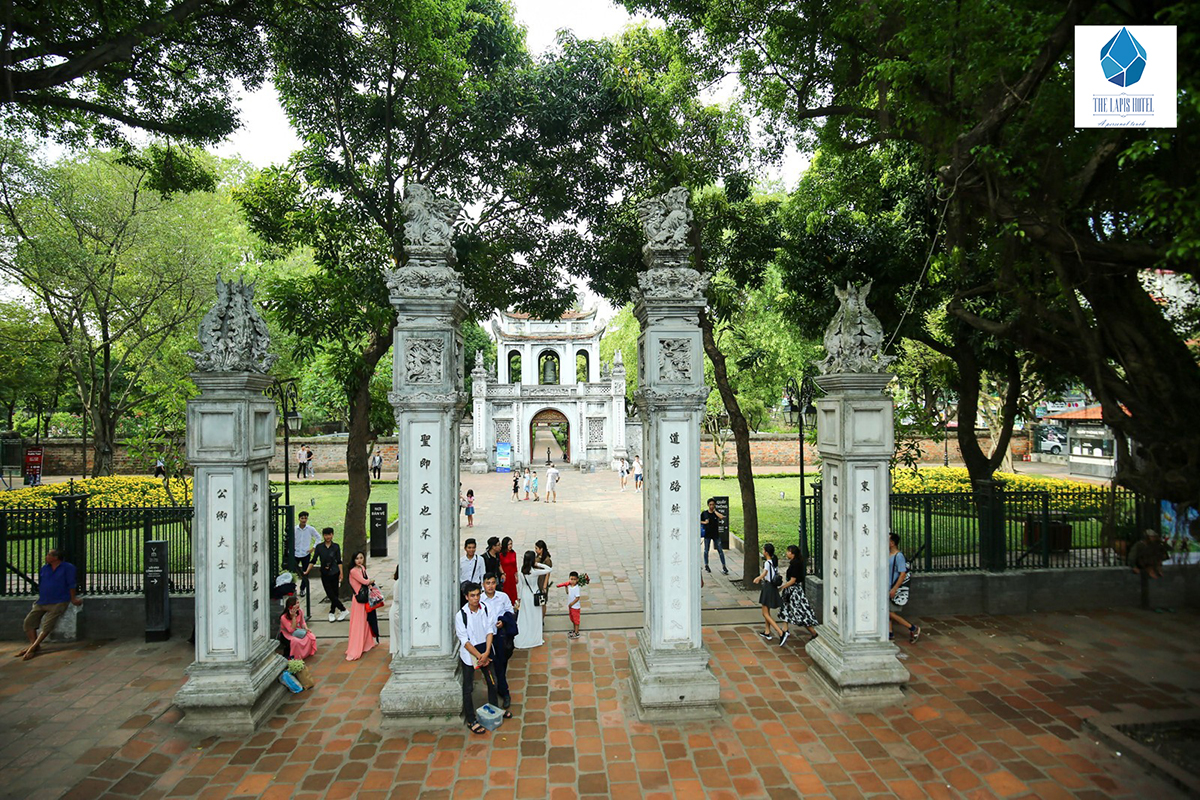
Giếng Thiên Quang
Giếng Thiên Quang has a square shape and is designed to be surrounded by a corridor. According to ancient explanations and beliefs, the square shape of Giếng Thiên Quang symbolizes the Earth, and the round opening on Khuê Văn Các symbolizes the Sky. The combination of these two structures represents the essence of the Earth and Sky, gathered at the largest cultural and educational center in the Thăng Long capital.
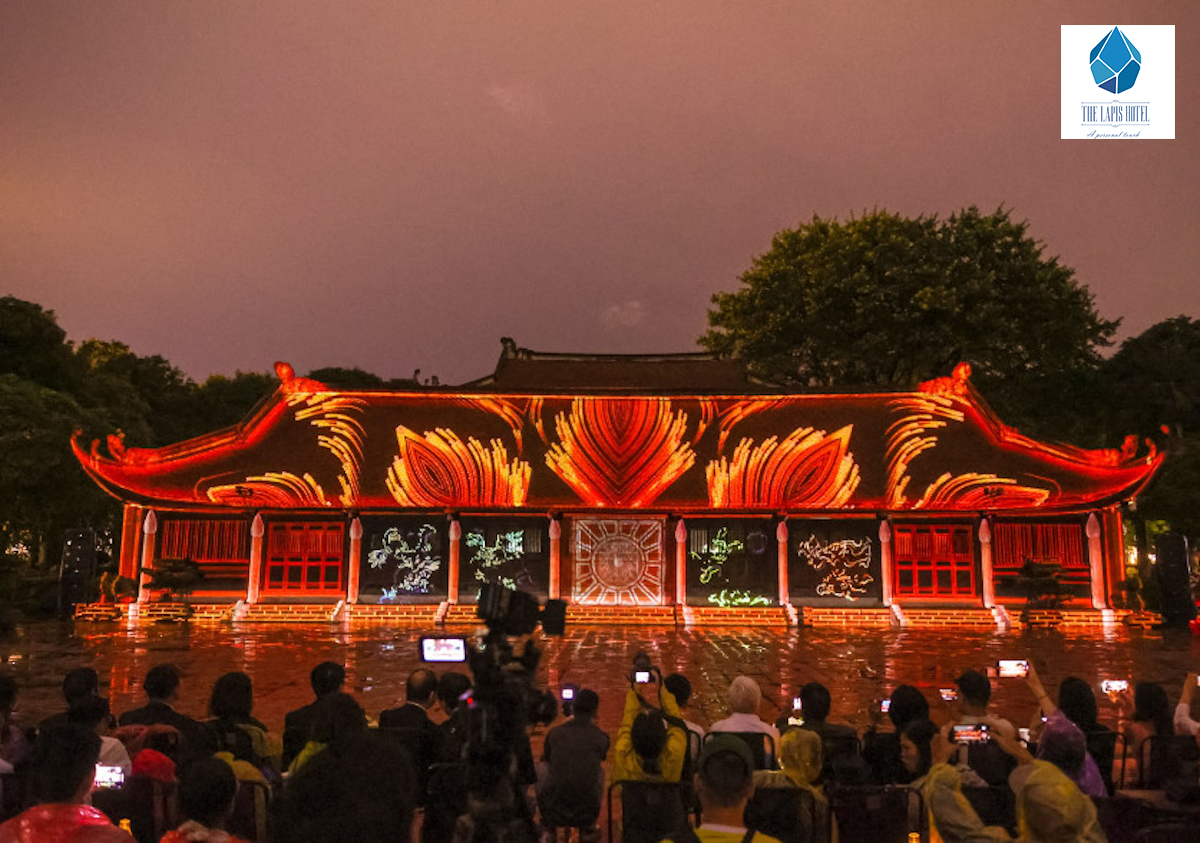
82 bia tiến sĩ
The 82 doctoral steles were built and created from large stone steles placed on either side of Giếng Thiên Quang. Each of these 82 steles rests on the back of 82 stone turtles, intricately and finely carved in various styles, with special spiritual significance. These steles honor the 82 top scholars who achieved the highest results in the imperial examinations during Vietnam’s feudal dynasties.
The 82 doctoral steles at the Temple of Literature and National University have been recognized by UNESCO as a Documentary Heritage and listed in the World Memory Global Register. This recognition signifies that the Temple of Literature and National University is not only a precious heritage and the spirit of our nation but has also become a cultural heritage of humanity.
Đền Khải Thánh
Đền Khải Thánh is a shrine dedicated to the parents of Confucius. It was originally part of Quốc Tử Giám, a place that trained and produced talents for various dynasties in the land of Vietnam. In 1946, this site was destroyed by French artillery, but Đền Khải Thánh was later rebuilt and has been preserved to this day, attracting visitors to explore its significance.
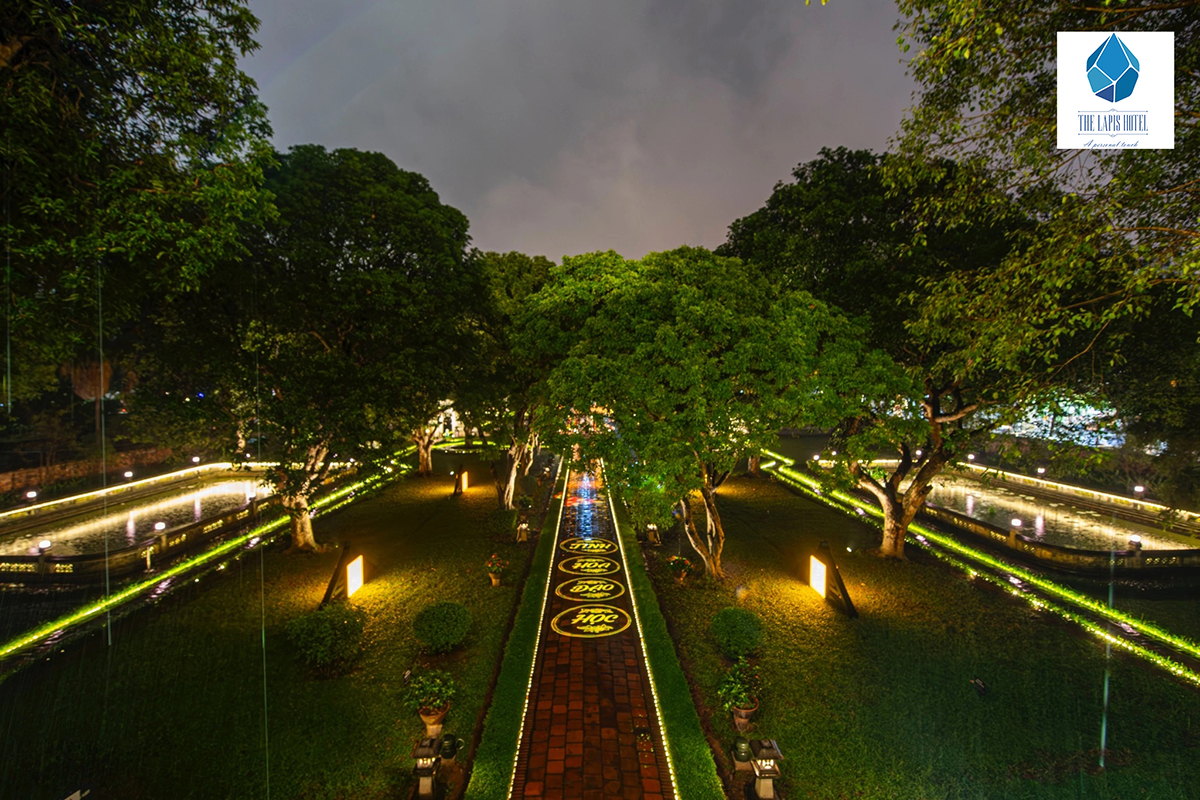
Đại Bái Đường
To reach the Đại Bái Đường shrine area, visitors need to pass through Đại Thánh Môn and a wide courtyard paved with Bát Tràng bricks. This solemn area includes nine compartments, with two side walls on either side. The central compartment is used to place an altar, while the remaining compartments are empty. The Đại Bái Đường shrine is used for ceremonial rites during ancient spring and autumn festivals
Đại Thành Môn
To reach the Đại Bái Đường shrine area, visitors need to pass through Đại Thánh Môn and a wide courtyard paved with Bát Tràng bricks. This solemn area includes nine compartments, with two side walls on either side. The central compartment is used to place an altar, while the remaining compartments are empty. The Đại Bái Đường shrine is used for ceremonial rites during ancient spring and autumn festivals
Detailed Information & Specific Directions for the Tour Route from The Lapis Hotel:
Destination: The Temple of Literature and National University is just a short distance from The Lapis Hotel, allowing easy travel with various means. At the Temple of Literature and National University, visitors will explore internal areas with thousand-year-old historical relics. Here, you will be guided through the history and gain useful knowledge and unique cultural insights
- Phone: 024 3633 3333
- Email: info@thelapishotel.com
- Official Website: https://thelapishotel.com
- Social Media: https://www.facebook.com/thelapishotel
- Adress: 21 Tran Hung Dao Street, Hoan Kiem Dist, Hanoi, Vietnam
- https://www.facebook.com/thelapishotel
